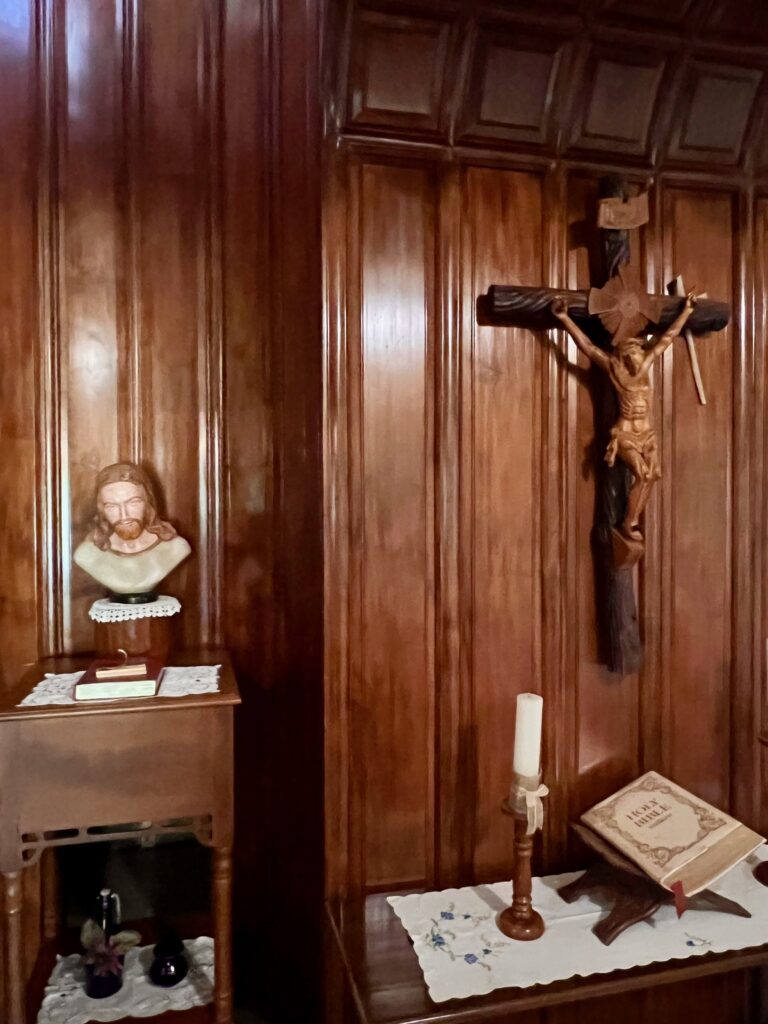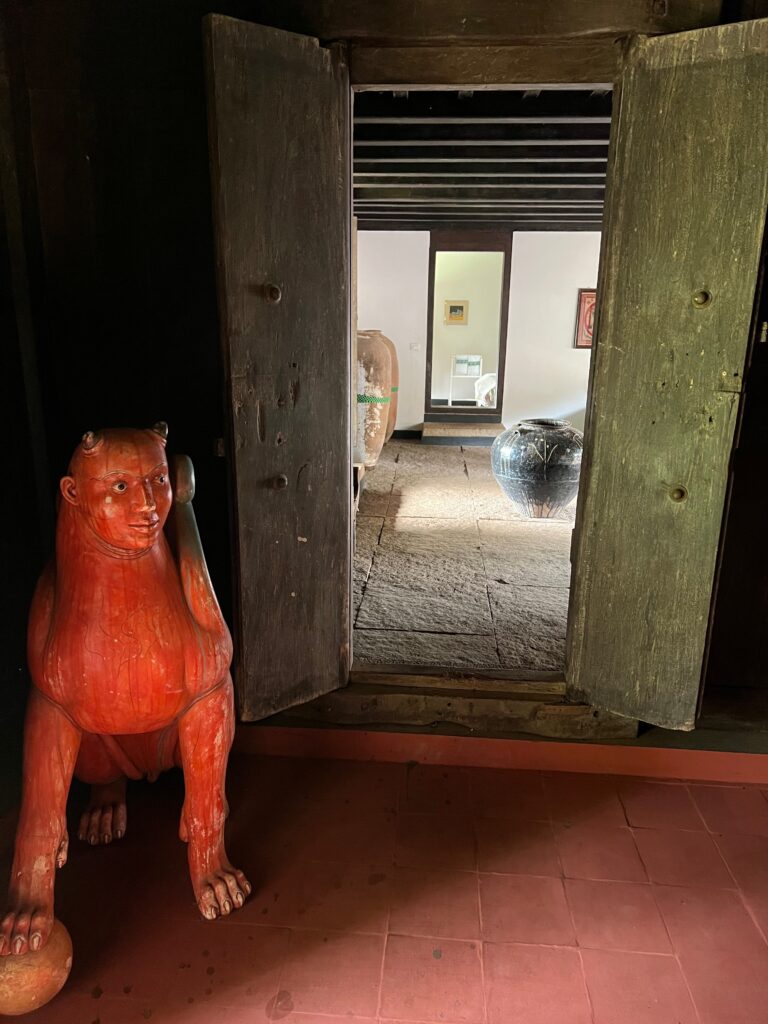While travelling in Tamil Nadu and Kerala, I stayed at three plantations. It appears that some plantations, in seeking new sources of revenue, are turning to the idea of offering quality hospitality to foreign tourists. It is a nice opportunity for a visitor to meet plantation owners and experience first hand Indian hospitality.
Rajakkad Estate
Of the three home stays I visited, the Rajakkad Estate was the most interesting. This beautiful wooden Pallam palace, was originally constructed in the nearby state of Kerala, about 225 km away from its present location. It was a summer palace of the Maharadjas of Travancore. It was built in the 18th century, and is an entirely wooden structure, made from interlocking beams, panels and screen, without a single mortice or tenon. A marvel of ingeniousness.
When it was bought by a wealthy British businessman in the mid 80’s, it was an abandoned building. So he set out to restore to its present state.
The state of Kerala, which ever since its independence in 1957, has elected several communist governments, apparently disapproved of a traditional palace being owned by a foreigner. So, rather than run the risk of expropriation, the gentleman, who was also a skilful engineer, dismantled the whole edifice and transported it over the state line into Tamil Nadu, to keep it out of reach. He then reassembled it to its present state. Quite an accomplishment, all the more so since it appears he had to do it twice before it ended up in its present location!
The palace is now located 1,000m above sea level, in a part of the Western Ghats foothills that have little changed over the last century. It is a good 50 Km away from Dindigul and now sits in the middle of a hybrid 40 acres coffee, black pepper and banana plantation, created at the time to generate revenue.
The palace was left to the gentleman’s son Francis, who converted it into a boutique hotel some 10 years ago. The limited number of rooms have all been fitted with modern amenities as well as nicely decorated. The property is co-owned by a Tamil resident, who was closely associated with Francis’ father.
The service and food are excellent. It is a wonderful haven for a solo traveller like me. The people you can meet there offer an opportunity for some stimulating conversations, something I welcomed after several weeks on the road.
Though nearly all the guests were Europeans, it is never the less a place where you can hear a lot about the older India of lore. Chance had it that my passage coincided with the beginning of Francis’ annual sojourn, both to check on the condition of the estate, and enjoy the place he so clearly loves. He was joined by his friend Crispin, who is helping him run things.
Francis is a very polished, middle-aged man, with impeccable manners. Of average height, with a thin, somewhat languid body posture, he likes to wear shorts, which give him an adolescent demeanour. Hiding behind a pair of black rimmed round glasses, he is very adept at jumping from one subject to another, betraying an unusual quirkiness, bordering on the unsettling.
Crispin, who, tongue-in-cheek, calls Francis “certifiably mad”, is a 77-year-old rotund Englishman, who has been living in France for close to 30 years. He is a typical product of British colonial times. Born in Scotland, he was brought up in South Africa and Kenya. At age 10, he came to London, whereupon, in arriving at Victoria station, he had his first culture shock: seeing white men actually carrying their bags! Mother, he confided, was very posh. So she checked everyone in at the Savoy, as one did in those days. They occupied three rooms – one for the parents, one for Crispin and his brother and one for Nanny. However, when she got the first bill, she was so horrified that she got everyone out and into a more modest Cromwell road affair. A few months later, he went to boarding school. Upon completing that, he found his way back in London, where he led the dissolute life of the 60s, full of sex, drugs, and rock & roll. And so on with his life story.
On my first day at the estate, I also met Michael and his partner, Ash. Michael was the perfect Englishman, who had a miserable childhood and still carried the trauma with him to this day. Ash, originally from India, had immigrated to England in his early childhood and spook a flawless English. The two have been together for some 30 years and travel a couple of times a year to India, where Ash’s family still lives.
In the evening, I had my first communal dinner with these gentlemen, all avowed homosexuals, but without ostentation. All with interesting lives. Crispin turned out to be a consummate host, who just loves to entertain people with his stories.
Over the following days, I had a couple of intriguing conversations with him. We swapped notes as to why each of us was living deliberately away from our home country. He, an Englishman, living in rural France, and I, a Frenchman, doing the same in rural England. I must admit, we didn’t manage to find much common ground for understanding each other’s real motives. Probably because it is easier to criticise what we hate about our respective countries, rather than admit what we secretly still really love about them. And also the opportunity to embody our native culture in a context other than that of home, maybe ?
During my stay I also met a French woman novelist, with that haughtiness French intellectuals love to display. She was an old acquaintance of both Crispin and Francis. Upon finding out that I too was French, she, in the middle of dinner one night, peremptorily exclaimed : “You know, you are not really French, you really are a Brit !” Well, of course, old girl, you know best.
There was also a younger English woman, Sophie, who had just become the widow of an old dying friend of hers, whom I gather she had agreed to marry just before his early death from a terminal condition. Nice person, brought out by Francis here to take her mind off things.
On another evening, I also met a set of three middle-aged French couples, from Brittany, all travelling together.
All in all, quite a varied company, though all, in one way or another, very attached to India.
Palakkad
The second home I visited, a few hundred kilometres away from Rajakkad Estate, was also in the Western Ghats, but on the Kerala side. Located in a hamlet some 40 kilometres from Palakkad town, the Planter’s Retreat Homestay is set amid a tropical organic plantation. A bigger plantation of around 100 acres, it consisted of 15,000 hevea trees (rubber), Areca palm trees (for betel nut), black pepper creepers, coconut and cacao trees, various other spice trees and exotic flowers. Often interspersed with one another.
Upon my arrival, I was formally welcomed by the whole family, headed by the patriarchal father. A warm welcome. After freshening up, we all took our places at a large dining table, where a lovely lunch was laid out : tapioca (Annie would have hated that !), fish and chicken curries, papadums and so on. Delicious. The three hosts sat across from me, father, son, and wife (at the end of the table). They explained they were going to eat in the traditional way, with their right hand, but I was welcome to use a fork and knife – which I lamely did, as I just couldn’t resolve myself to eat with my fingers. Food for me just doesn’t taste the same when using one’s fingers.
The manor house, in which they all live, is a substantial structure, well-built, with quality materials, a lot originating from the estate itself. Dating from the early 1990s, it replaced many of the older and smaller buildings that had once housed the original founding great grandfather.
Today the plantation is run by Vivex, a third generation descendant. In his late forties, he is an electrical software engineer by training, though he told me he always knew that one day he would be taking over the management of the plantation from his aging father. He in turn has 3 children, all at present in school, and none of whom are expected to take over from him.
Their prime crop is rubber.

I learned that latex, which is collected near daily, so it does not coalesce in the collecting cups, has an interesting story to it. It is one of the rare natural products which survives the onslaught of petroleum derivatives, such as synthetic rubber. There are two markets for latex. The first is rubber for heavy-duty tires (for lorries, earth moving equipment, when it is blended with synthetic rubber, and for aircraft tires, when it is 100% latex as no synthetic product has the strength and combined elasticity not to burst on landing!). The second outlet is medical equipment such as gloves, condoms etc… The COVID outbreak was a bonanza for this latter strand.
The times, however, are changing. While latex still has good days ahead, the issue today is finding the manual labour. Latex is not only labour-intensive, but requires a skilled labour. They believe the days of running an economical latex plantation are numbered, and the survival of the farm will depend largely on their successful attempts at diversification. They are constantly looking for alternative crops. In addition to all those trees already named above, they are trying exotic fruit trees, and experimenting with lime trees, vanilla plants etc.

These were well-educated people, with broad world views and a welcoming sense of hospitality. They are also very traditional people, with the women in the kitchen while the men are being served dinner.
I was struck by how deeply Christian they were. Their hallway has a beautifully carved crucifix and an open bible stand. Such a strong affirmation of faith, despite India’s polytheist attitude towards all religious faith, and strong hindou majority, did somewhat surprise me by its overtness.
This plantation, which has been operational for 75 years, clearly owes its success to its family cohesion over three generations. Being deeply catholic, inheritance will to be evenly split between siblings, regardless of gender. Which will generate issues of ownership fragmentation and no doubt compound the radical changes that will be required to ensure the eventual survival of the plantation. Rendered all the more tricky since the state of Kerala limits land ownership to 15 acres per household.
Sultan’s Battery
The last home stay I visited was called Amaryllis, located in Sultan’s Battery, some 200 km north of Palakkad, still in the state of Kerala. It was a coffee plantation, more in name than in reality, given its small size. It was the residence of Victor and Jini. He was an old hand at plantation life, having managed a much larger estate in earlier days. Today though, they are really focussing on running a hospitality business.
The estate could accommodate up to 7 guests and had two tree houses, one of which I was lucky to occupy. Great views from up there.
Despite the place being at over 1,200 meters, there was abundant wildlife around. Elephants, tigers (one had been accidentally caught in a noose intended for wild boar, and died), leopards (I actually was lucky enough to see one), snakes, monkeys and what not. All in all though, a nice place to stay at, with Victor entertaining his guests in style, in his old-fashioned bar in the evening.

